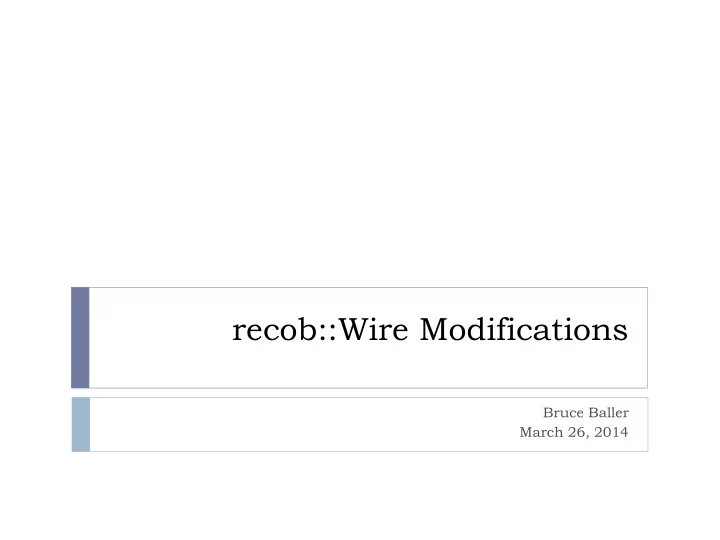

recob::Wire Modifications Bruce Baller March 26, 2014
Outline Motivation for changing recob::Wire Regions Of Interest (ROIs) concept Implementation for MicroBooNE Pros and Cons Slides for later discussion Ruminations on other RecoBase objects 2
Motivation Wire signal and raw signal data products contain the full readout window but the non-zero signal occupancy (aka Region of Interest) is low Current scheme is to deconvolve RawDigits in all time bins on each wire FFT requires data to be put in an array of size 2 N complex numbers – complex doubles since we are using ROOT For MicroBooNE Single 3200 tick readout frame 2 x 4096 numbers Single 9600 tick readout frame 2 x 16384 numbers Lots of unnecessary computation and storage 3
Current & Proposed Schemes Current scheme CalWire Initialize FFT service with FFTSize = ReadOutWindowSize Deconvolve RawDigits and create recob::Wire fSignal HitFinder Find Signal regions above threshold Fit to N Gaussians and create recob::Hits Proposed scheme CalWire Initialize FFT service with fcl file selectable FFTSize Find fabs(RawDigit) regions above threshold (= ROIs) Deconvolve ROIs and create Wire SignalROI() HitFinder – 2 options Modify: Fit to N Gaussians using SignalROIs Don’t modify: Use Wire Signal() method to get a zero padded signal vector of length ReadOutWindowSize 4
Wire Signal – Current Scheme ReadOutWindowSize ticks Wire RawDigit() vector<short> Deconvolve ReadOutWindowSize ticks Signal() vector<float> Note: ALL wire planes are deconvolved ALL wire plane signals have ReadOutWindowSize ticks 5
Wire Signal ROI Scheme ReadOutWindowSize ticks Wire RawDigit() vector<short> ROI[0] ROI[1] ROI[2] Small fixed FFT size vector<float> ROI[1] ROI[2] ROI[0] Tick[0] Tick[1] Tick[2] Deconvolve Modified Wire object: vector<pair<unsigned int, vector<float>>> ROI[0] ROI[1] ROI[2] Tick[0] Tick[1] Tick[2] 6
What fraction of the Signal contains hit information? - MicroBooNE totLen = S bin length of all ROIs on a wire Test with 10 events from previous Occupancy per wire = totLen / dataSize MCC challenge – Genie + cosmics Ave occupancy = 0.4% Test with 100 events from nue_cosmic_3window Ave occupancy = 0.3% 7
Wire.h Current 8
Wire.h Proposed 9
Wire.cxx Proposed 10
MicroBooNE Implementation uboonecode/CalWireROI_module.cc fcl inputs fThreshold ( = 3) fMinWid ( = 4) fMinSep ( = 10) min separation between ROIs fROIPad ( = 10) pad ends of ROIs with signal baseline SignalROI[0] SignalROI[1] 11
ArgoNeuT CalWire modification one big ROI per wire 12
Change CCHitFinder to use ROIs Get the ROIs on the wire Find N bumps within the ROI Fit to N Gaussians 13
Summary Pros Significant reduction in memory and file size using ROIs New Signal get method returns a zero-padded vector ala the old Wire object Minimal changes to event display & hit finders The “bump hunting” code in the hit finders can be eliminated if the SignalROI get method is used HitFinder HitFitter Cons A means of reading/converting existing MC files is needed if this is deemed to be a requirement – is it? Alternatively, one could read existing MC files with v1_00_05 14
Ruminations on other RecoBase objects Use “graded approach” when considering changes to add or remove features Roughly speaking … Thousands of hits per event be hard-nosed Hundreds of clusters per event Tens of tracks per event be loose 15
Ruminations on recob::Hit Used PeakTime x T otCharge dQ/dx s = EndTime - PeakTime Multiplicity, GoodnessOfFit Float has sufficient Confusing precision maxCharge = amplitude Hit position resolution > totCharge = 2 p s Amp 200 m m (x max ~ 250.02 cm) Not filled/used/needed Wire-to-wire ionization Sigma… fluctuations are large ~30% 16
Ruminations on recob::Cluster Track- like clusters… Not useful Cluster charge at Start/End would be useful fT otalCharge for 3D track matching fdQdW (varies) ClusterCrawler defines Cluster slope Begin == end of the cluster Start dTdW End dTdW with the lower charge Float has adequate precision – ala Hit 17
Recommend
More recommend